Evaluation on Air Purifier’s Performance in Reducing the Concentration of Fine Particulate Matter for Occupants according to its Operation Methods
Abstract
1. Introduction
2. Materials and Methods
2.1. Experiment Equipment and Method
2.2. Arrangement of the Air Purifier Considering Draft
2.3. Real-time Monitoring and Transfer Unit Production Using an Arduino Board
3. Measurement Experiment with Fixed Air Purifier
3.1. Case Setting
3.2. Experiment Results
4. Measurement Experiment with Movable Air Purifier
4.1. Operating Method of Movable Air Purifier
4.1.1. Real-Time Occupant Tracking Method
4.1.2. Zone Controlling Method
4.2. Experiment Results
5. Conclusions
Author Contributions
Funding
Conflicts of Interest
References
- Dockery, D.W. Health effects of particulate air pollution. Ann. Epidemiol. 2009, 19, 257–263. [Google Scholar] [CrossRef] [PubMed]
- Yamaguchi, N.; Ichijo, T.; Sakotani, A.; Baba, T.; Nasu, M. Global dispersion of bacterial cells on Asian dust. Sci. Rep. 2012, 2, 525–529. [Google Scholar] [CrossRef] [PubMed]
- World Health Organization. Household Air Pollution and Health. Available online: http://www.who.int/news-room/fact-sheets/detail/household-air-pollution-and-health (accessed on 24 January 2020).
- United States Environmental Protection Agency. Particulate Matter (PM) pollution. Available online: https://www.epa.gov/pm-pollution (accessed on 24 January 2020).
- Kim, K.; Kabir, E.; Kabir, S. A review on the human health impact of airborne particulate matter. Environ. Int. 2015, 74, 136–143. [Google Scholar] [CrossRef] [PubMed]
- Franck, U.; Odeh, S.; Wiedensohler, A.; Wehner, B.; Herbarth, O. The effect of particle size on cardiovascular disorders—The smaller the worse. Sci. Total Environ. 2011, 409, 4217–4221. [Google Scholar] [CrossRef]
- Ristovski, Z.D.; Miljevic, B.; Surawski, N.C.; Morawska, L.; Fong, K.M.; Goh, F.; Yang, I.A. Respiratory health effects of diesel particulate matter. Respirology 2012, 17, 201–212. [Google Scholar] [CrossRef]
- Brook, R.D.; Rajagopalan, S.; Pope, C.A.; Brook, J.R.; Bhatnagar, A.; Diez-Roux, A.V.; Holguin, F.; Hong, Y.; Luepker, R.V.; Mittleman, M.A.; et al. Particulate matter air pollution and cardiovascular disease: An update to the scientific statement from the American heart association. Circulation 2010, 121, 2331–2378. [Google Scholar] [CrossRef]
- Hoek, G.; Krishnan, R.M.; Beelen, R.; Peters, A.; Ostro, B.; Brunekreef, B. Long-term air pollution exposure and cardio-respiratory mortality: A review. Environ. Health 2013, 12, 43. [Google Scholar] [CrossRef]
- Shah, A.S.; Lee, K.K.; Mcallister, D.A.; Hunter, A.; Nair, H.; Whiteley, W.; Langlish, J.P.; Newby, D.E.; Mills, N.L. Short term exposure to air pollution and stroke: Systematic review and meta-analysis. BMJ 2015, 350, h1295. [Google Scholar] [CrossRef]
- Fisk, W.J.; Faulkner, D.; Palonen, J.; Sepanen, O. Performance and costs of particle air filtration technologies. Indoor Air 2002, 12, 223–234. [Google Scholar] [CrossRef]
- Cha, D.W.; Kim, S.H.; Cho, S.Y. Radon reduction efficiency of the air cleaner equipped with a Korea carbon filter. J. Odor Indoor Environ. 2017, 16, 364–368. [Google Scholar] [CrossRef]
- Urso, P.; Cattaneo, A.; Garramone, G.; Peruzzo, C.; Cavallo, D.M.; Carrer, P. Identification of particulate matter determinants in residential homes. Build. Environ. 2015, 86, 61–69. [Google Scholar] [CrossRef]
- Liuliu, D.; Batterman, S.; Parker, E.; Godwin, C.; Chin, J.; O’Toole, A.; Robins, T.; Brakefield-Caldwel, W.; Lewis, T. Particle concentrations and effectiveness of free-standing air filters in bedrooms of children with asthma in Detroit, Michigan. Build. Environ. 2011, 46, 2303–2313. [Google Scholar] [CrossRef]
- Ma, H.; Shen, H.; Shui, T.; Li, Q.; Zhou, L. Experimental study on ultrafine particle removal performance of portable air cleaners with different filters in an office room. Int. J. Environ. Res. Public Health 2015, 13, 102. [Google Scholar] [CrossRef] [PubMed]
- Fermo, P.; Comite, V.; Falciola, L.; Guglielmi, V.; Miani, A. Efficiency of an air cleaner device in reducing aerosol particulate matter (PM) in indoor environments. Int. J. Environ. Res. Public Health 2020, 17, 18. [Google Scholar] [CrossRef] [PubMed]
- Park, J.H.; Lee, T.J.; Park, M.J.; Oh, H.; Jo, Y.M. Effect of air cleaners and school characteristic on classroom concentration of particulate matter in 34 elementary schools in Korea. Build. Environ. 2019, 167, 106437. [Google Scholar] [CrossRef] [PubMed]
- Oh, H.J.; Nam, I.; Yun, H.; Kim, J.; Yang, J. Characterization of indoor air quality and efficiency of air purifier in childcare centers, Korea. Build. Environ. 2014, 82, 203–214. [Google Scholar] [CrossRef]
- Ciuzas, D.; Prasauskas, T.; Krugly, E.; Jurelionis, A.; Seduikyte, L.; Martuzevicius, D. Indoor air quality management by combined ventilation and air cleaning: An experimental study. Aerosol Air Qual. Res. 2016, 16, 2550–2559. [Google Scholar] [CrossRef]
- Li, Z.; Wen, Q.; Zhang, R. Sources, health effects and control strategies of indoor fine particulate matter (PM2.5): A review. Sci. Total Environ. 2017, 586, 610–622. [Google Scholar] [CrossRef]
- Goldstein, J.I.; Newbury, D.E.; Michael, J.R.; Ritchie, N.W.M.; Scott, J.H.J.; Joy, D.C. Scanning Electron Microscopy and X-ray Microanalysis; Springer: Berlin, Germany, 2017. [Google Scholar]
- Nazaroff, W.W. Indoor particle dynamics. Indoor Air 2004, 175–183. [Google Scholar] [CrossRef]
- Liu, D.; Nazaroff, W.W. Modeling pollutant penetration across building envelopes. Atmos. Environ. 2001, 35, 4451–4462. [Google Scholar] [CrossRef]
- Wallace, L.A.; Emmerich, S.J.; Howard-reed, C. Continuous measurements of air change rates in an occupied house for 1 year: The effect of temperature, wind, fans, and windows. J. Expo. Anal. Environ. Epidemiol. 2002, 12, 296–306. [Google Scholar] [CrossRef] [PubMed]
- Long, C.M.; Suh, H.H.; Catalano, P.J.; Koutrakis, P. Using time-and size-resolved particulate data to quantify indoor penetration and deposition behavior. Environ. Sci. Technol. 2001, 35, 2089–2099. [Google Scholar] [CrossRef] [PubMed]
- Gong, N.; Tham, K.W.; Melikov, A.K.; Wyon, D.P.; Sekhar, S.C.; Cheong, K.W. The acceptable air velocity range for local air movement in the tropics. HVAC&R Res. 2006, 12, 1065–1076. [Google Scholar] [CrossRef]
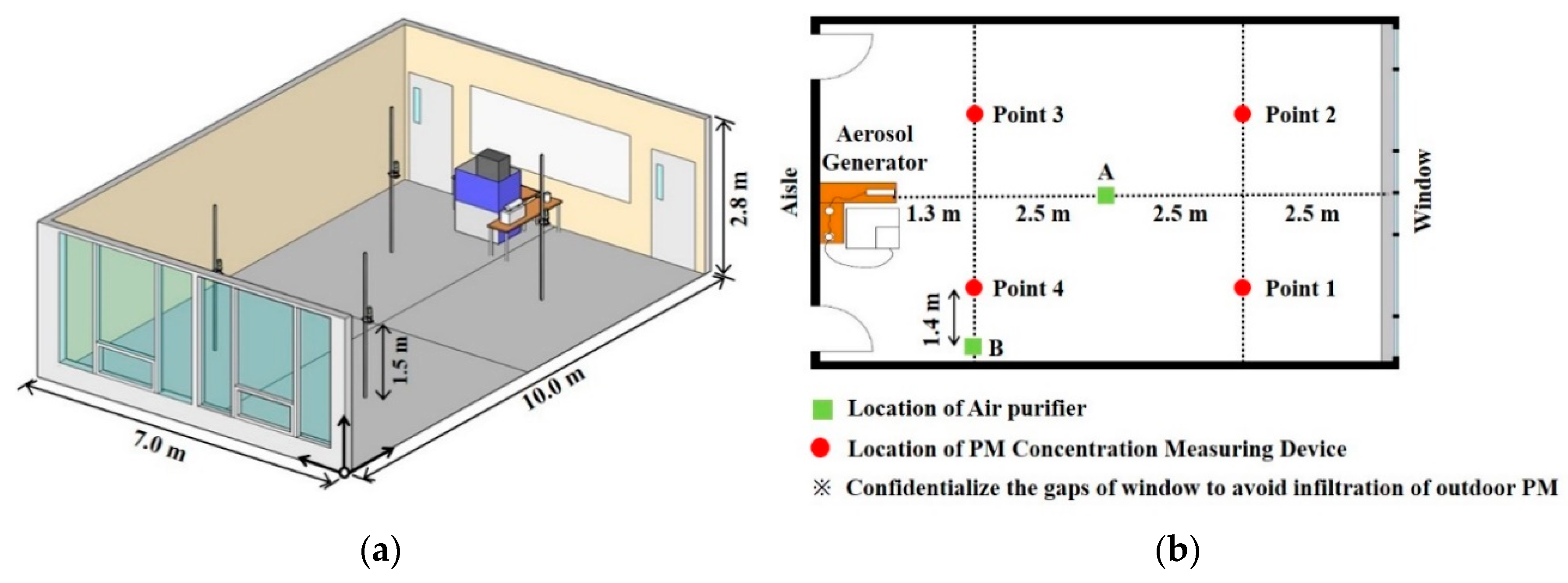
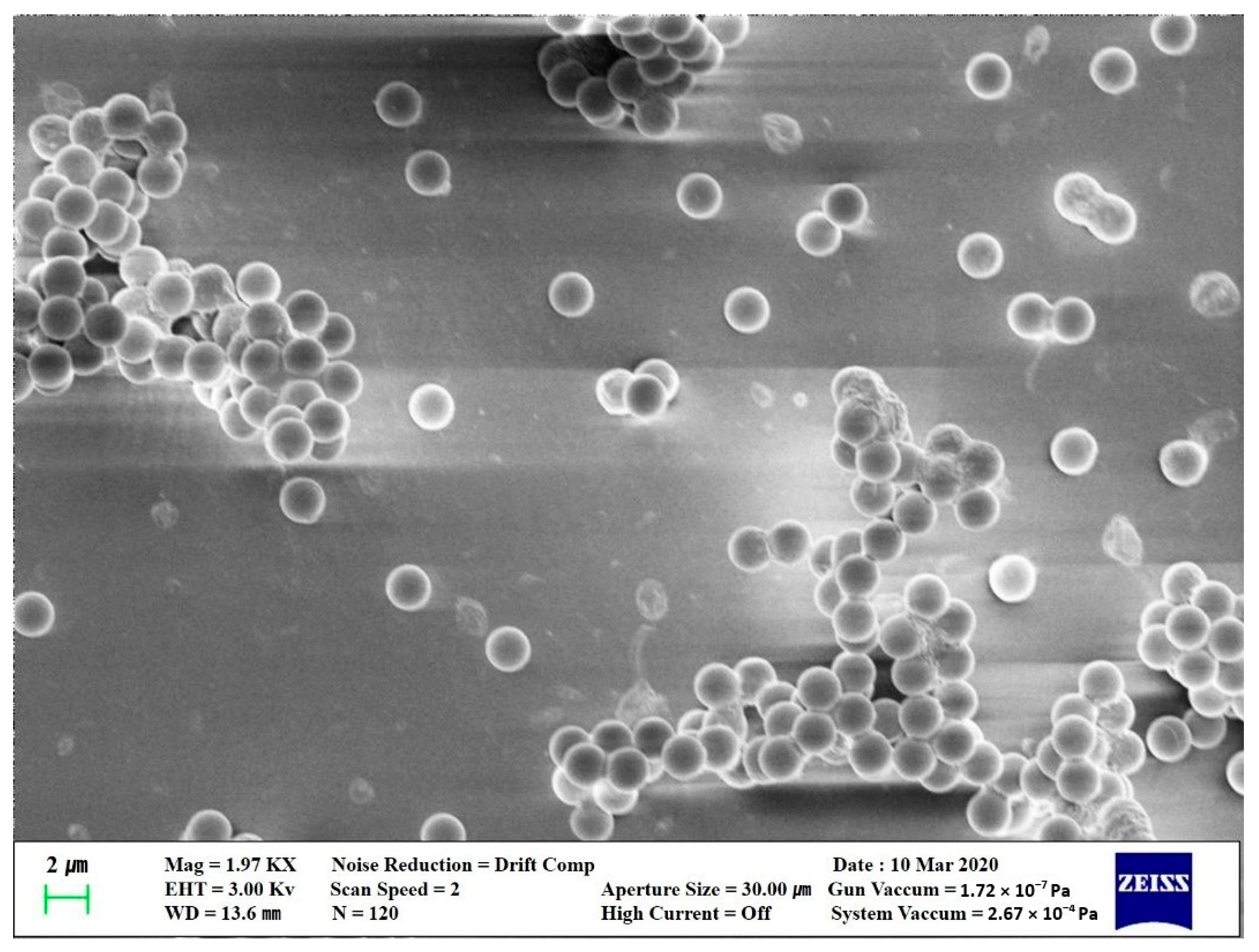
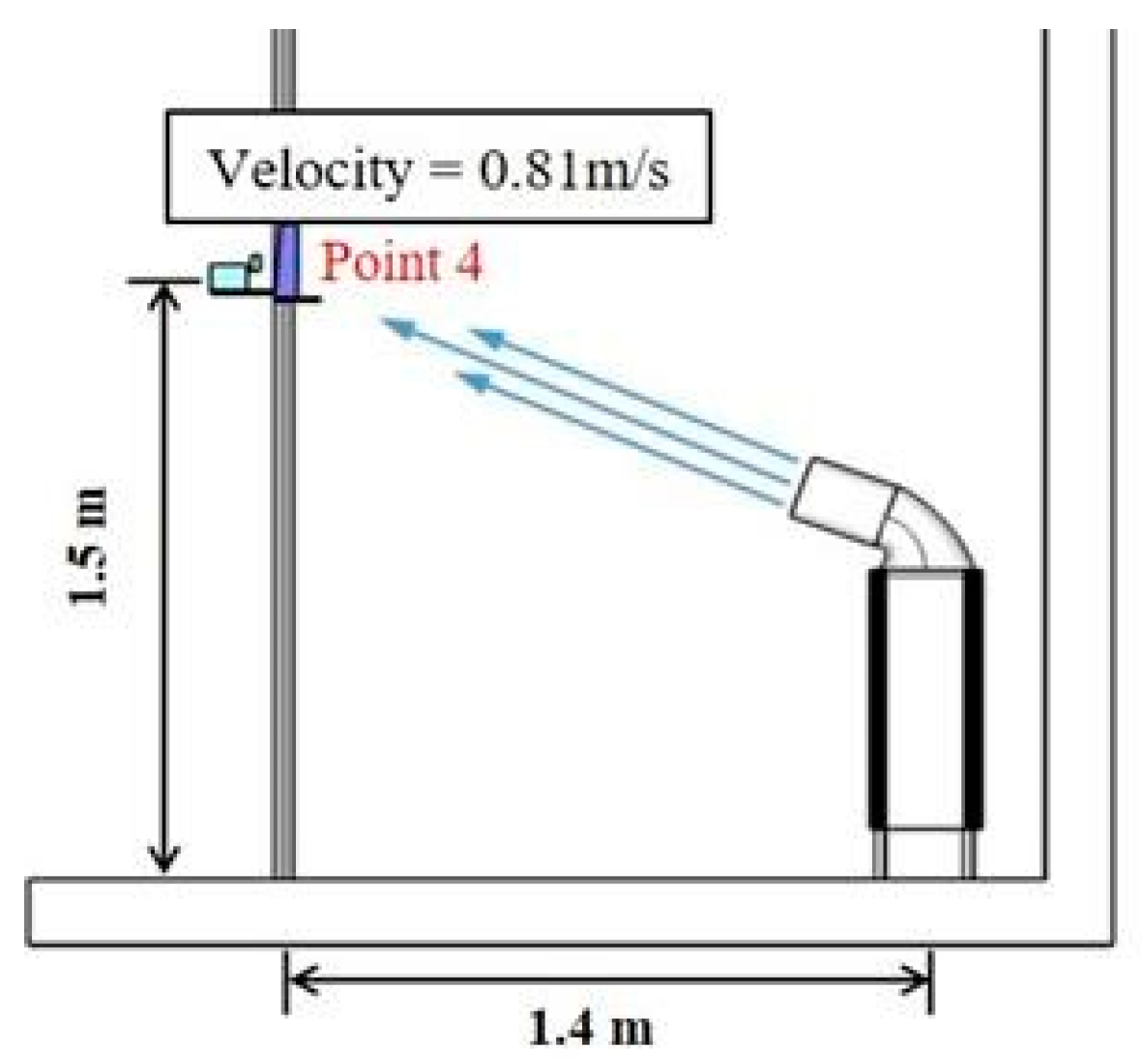
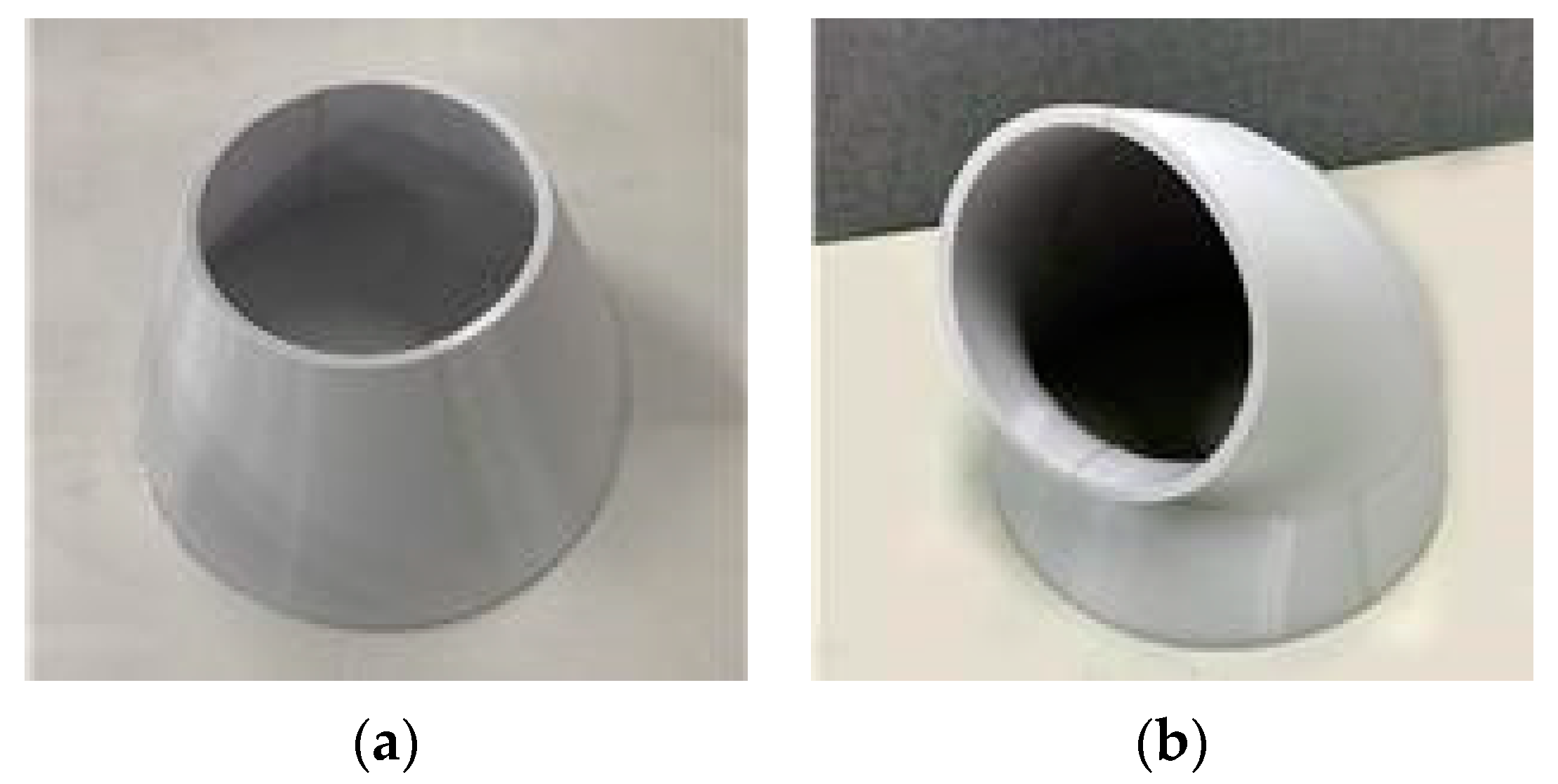
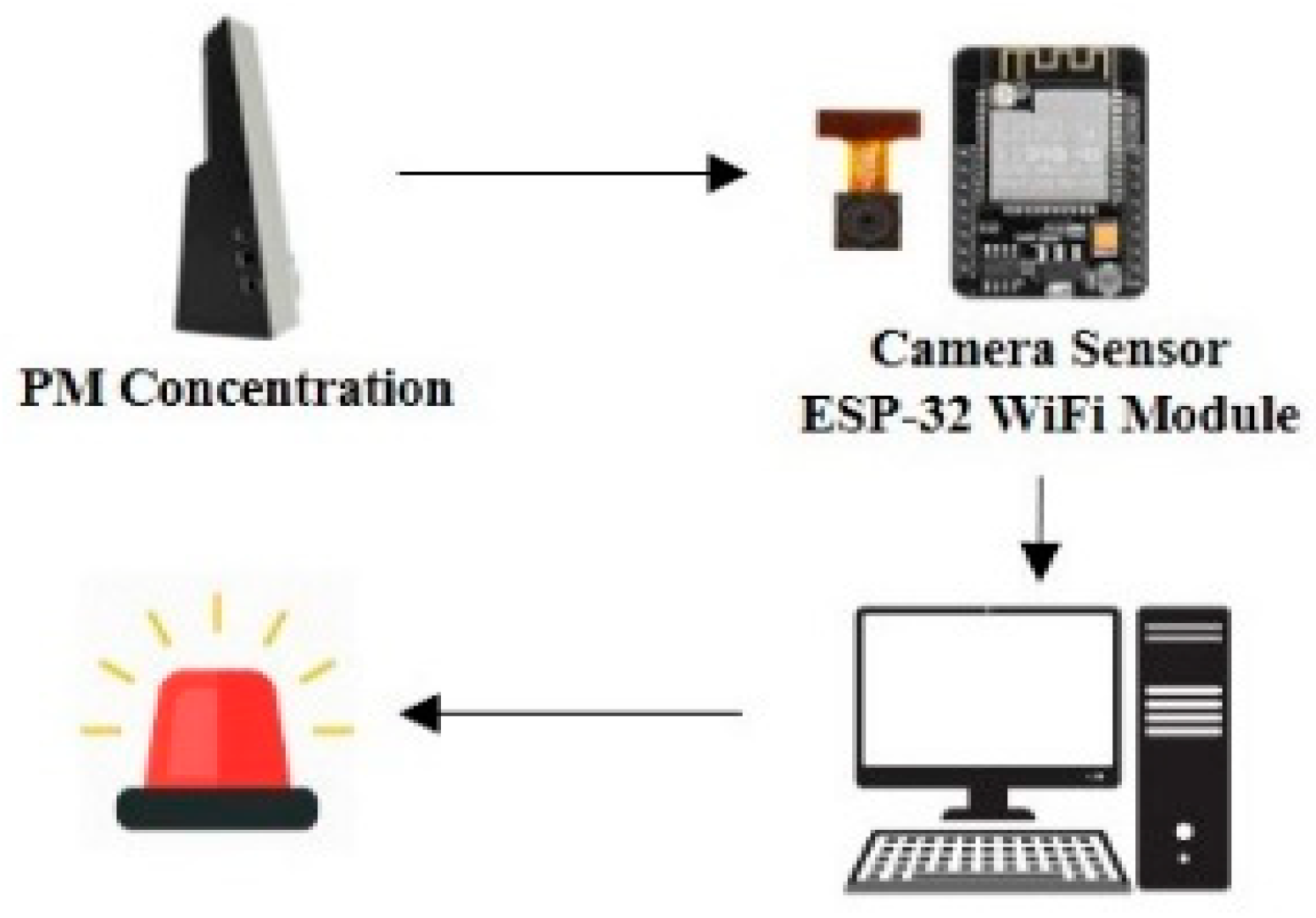




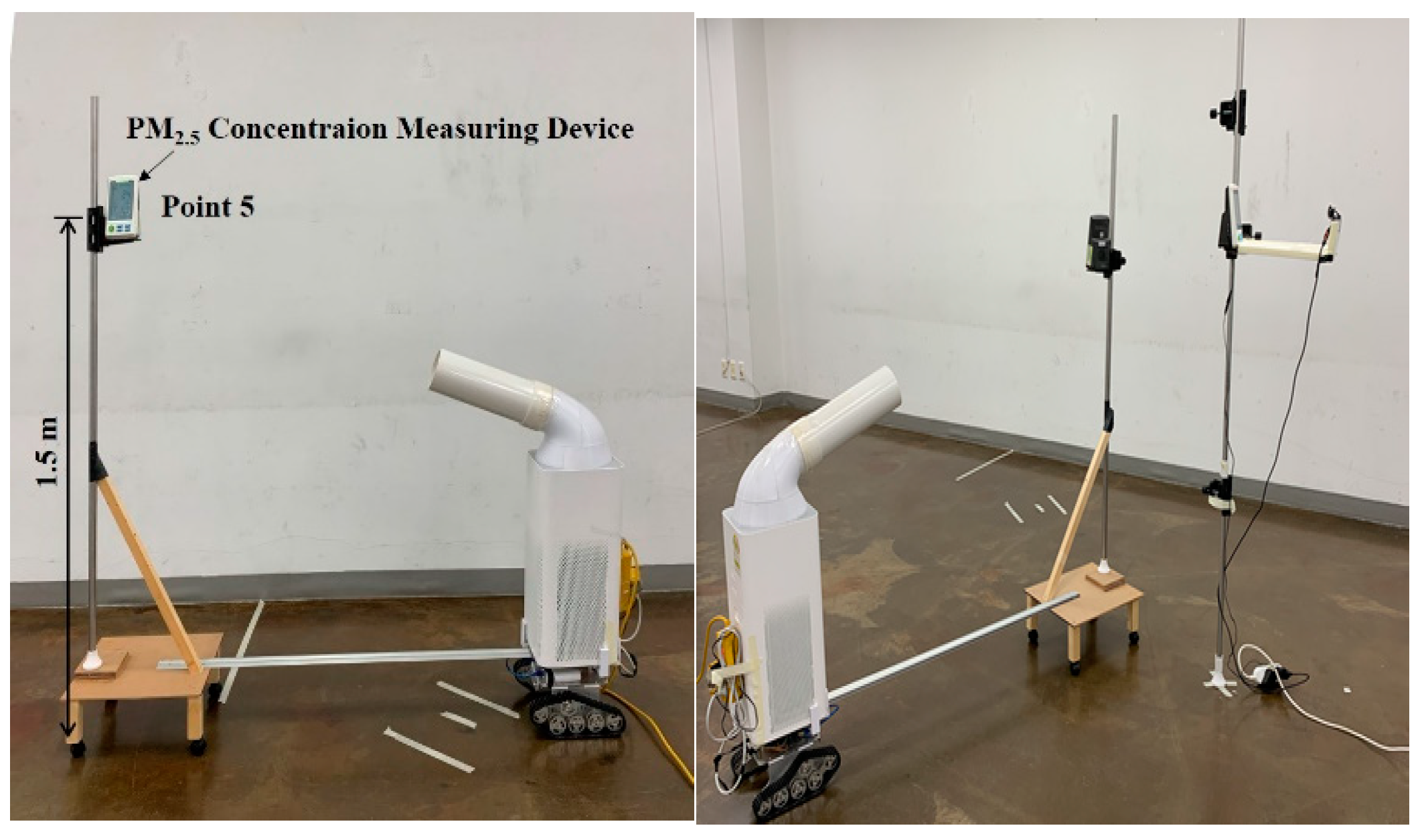

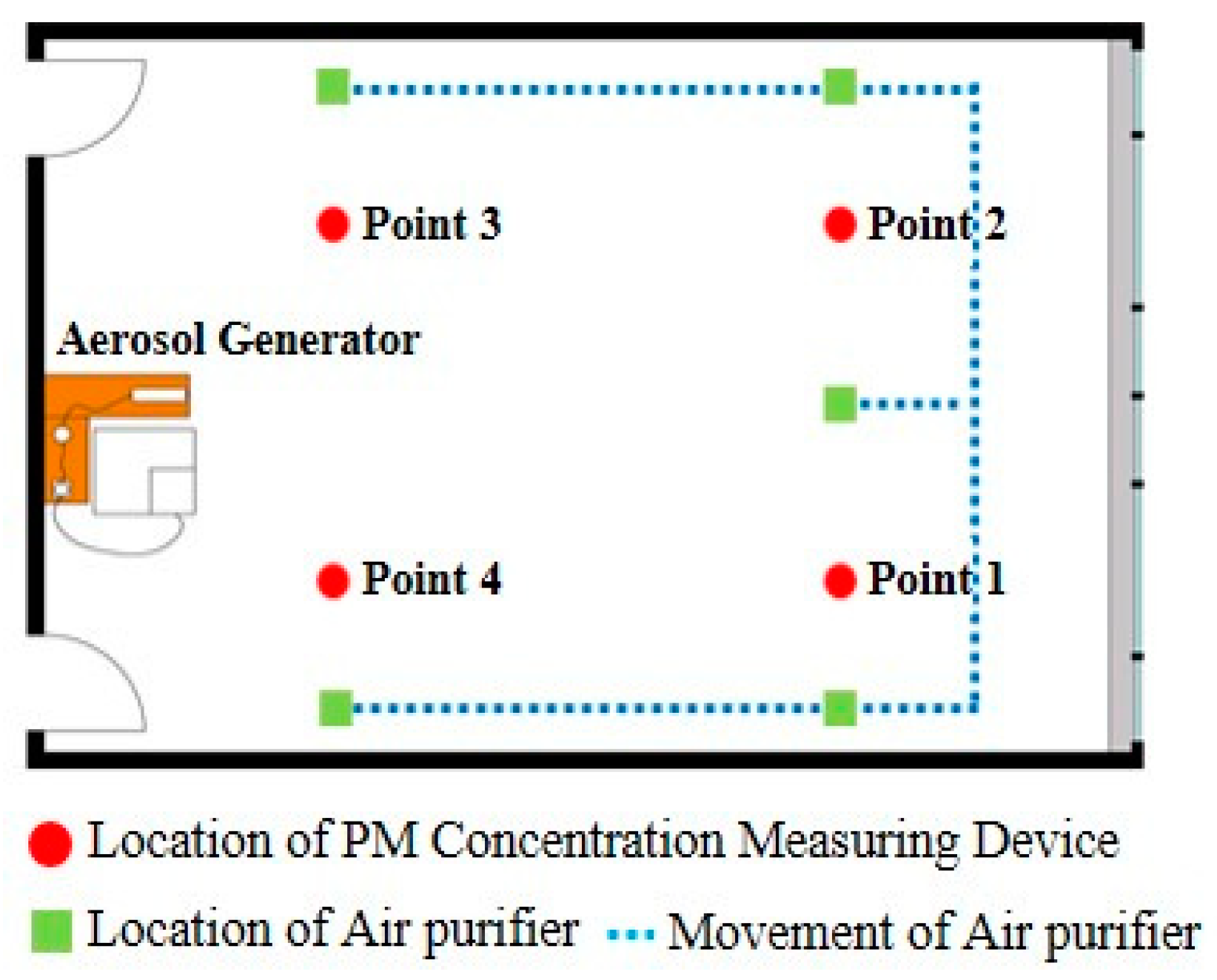
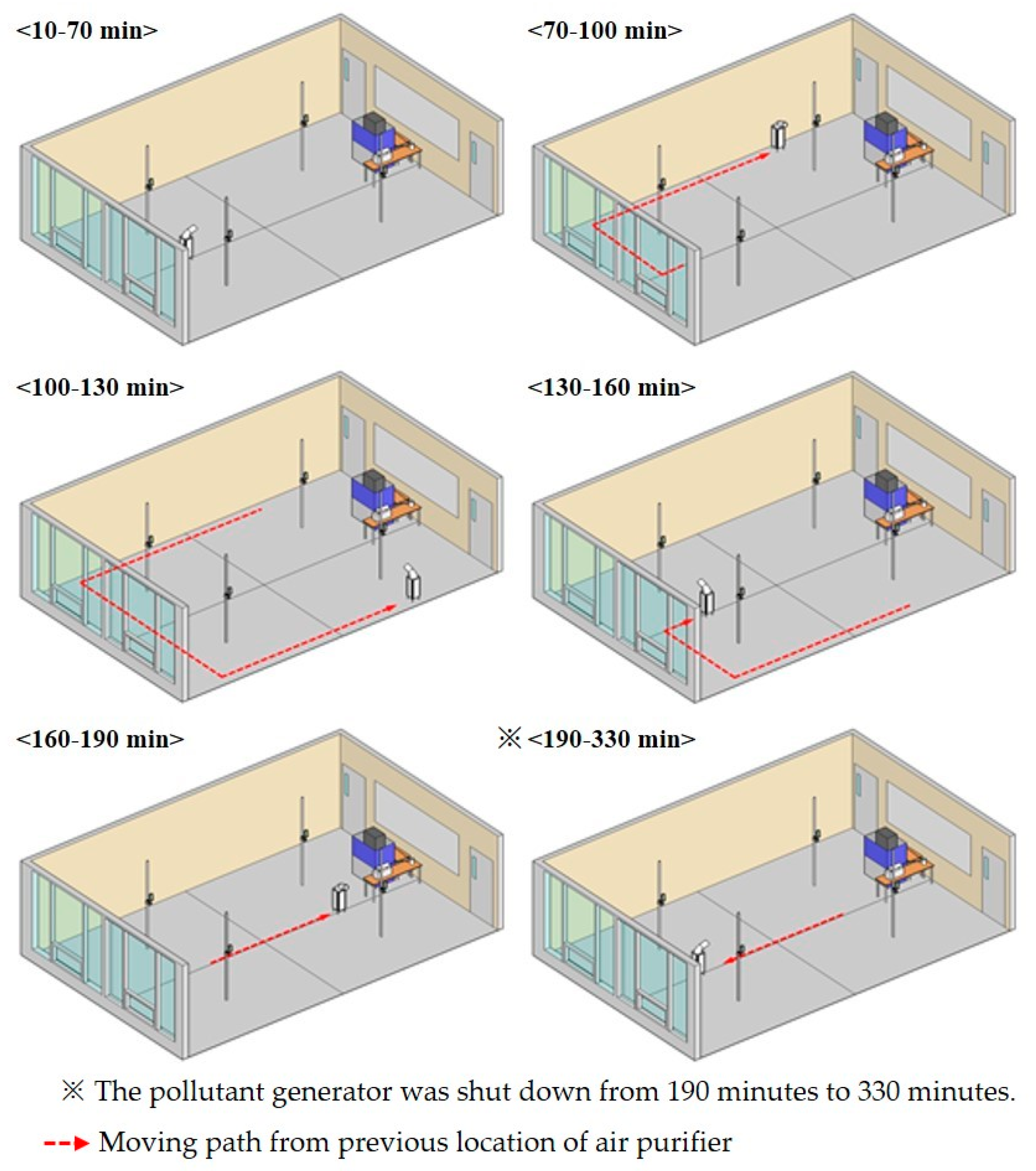
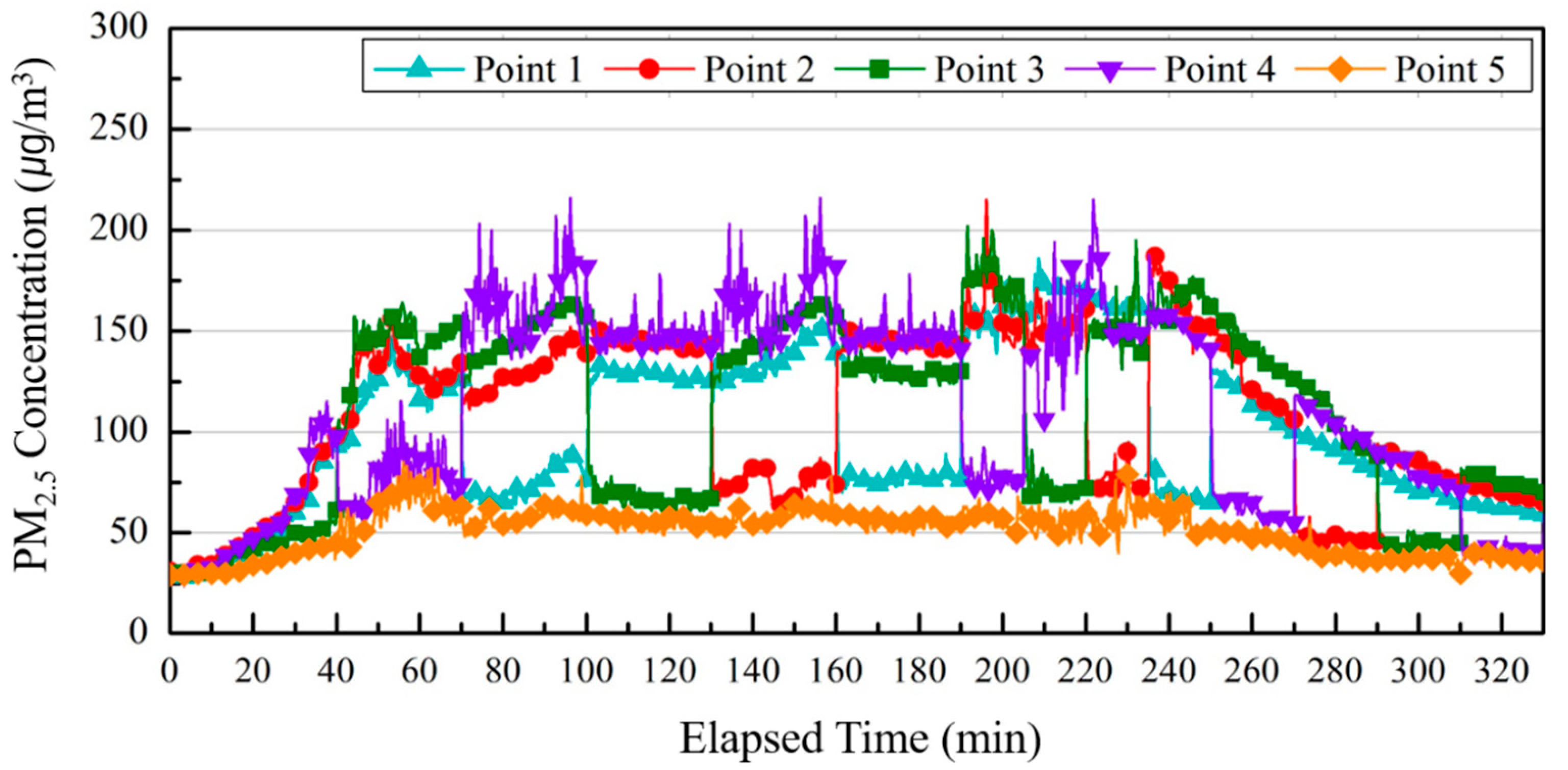
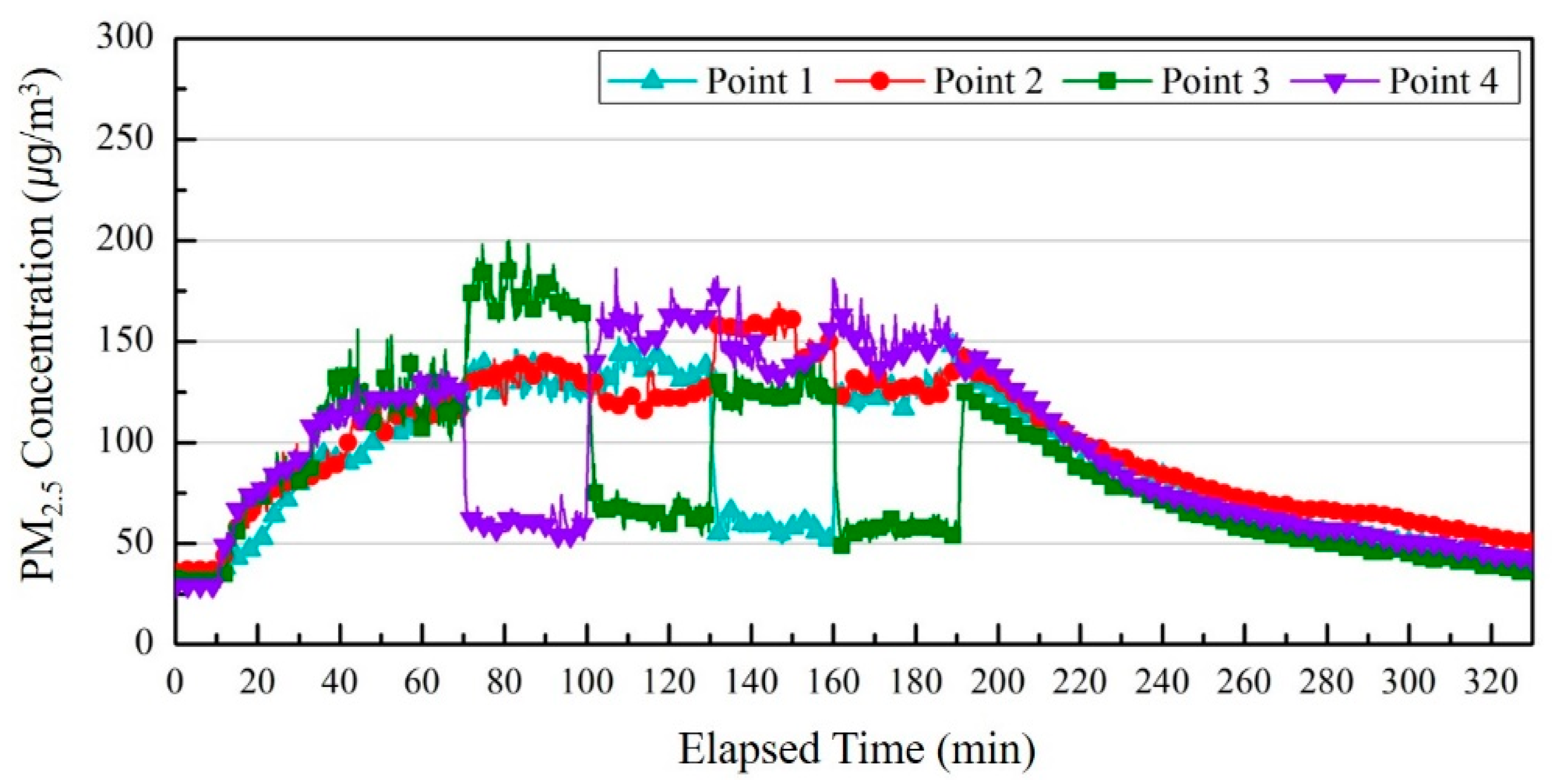
| Purpose | Model | Quantity |
|---|---|---|
| Air purifier | Mi Air 2 | 1 |
| PM measuring device | TES-5322 | 5 |
| Thermo-hygrometer | TR-72WF | 4 |
| Anemometer | TSI 9565 | 1 |
| PM2.5 generating device | Aerosol generator | 1 |
| Standard particle solution | Polystyrene Latex (Standard particle 15 mL) | 3 |
| Air supply and flow control of aerosol generator | Compressor (AM 400D) | 1 |
| Water removal of aerosol air supply | Dryer (TX15K) | 1 |
| Cases Variables | 1 | 2 | 3 | 4 | |
|---|---|---|---|---|---|
| Location of air purifier | A | B | A | B | |
| Direction of discharge | Upward | Toward point 4 | |||
| Initial PM concentration | 27 μg/m3 | 26 μg/m3 | 29 μg/m3 | 30 μg/m3 | |
| Temperature/Relative Humidity | 25 ± 2.2 °C/28 ± 1.8% | ||||
© 2020 by the authors. Licensee MDPI, Basel, Switzerland. This article is an open access article distributed under the terms and conditions of the Creative Commons Attribution (CC BY) license (http://creativecommons.org/licenses/by/4.0/).
Share and Cite
Park, H.; Park, S.; Seo, J. Evaluation on Air Purifier’s Performance in Reducing the Concentration of Fine Particulate Matter for Occupants according to its Operation Methods. Int. J. Environ. Res. Public Health 2020, 17, 5561. https://doi.org/10.3390/ijerph17155561
Park H, Park S, Seo J. Evaluation on Air Purifier’s Performance in Reducing the Concentration of Fine Particulate Matter for Occupants according to its Operation Methods. International Journal of Environmental Research and Public Health. 2020; 17(15):5561. https://doi.org/10.3390/ijerph17155561
Chicago/Turabian StylePark, Hyungyu, Seonghyun Park, and Janghoo Seo. 2020. "Evaluation on Air Purifier’s Performance in Reducing the Concentration of Fine Particulate Matter for Occupants according to its Operation Methods" International Journal of Environmental Research and Public Health 17, no. 15: 5561. https://doi.org/10.3390/ijerph17155561
APA StylePark, H., Park, S., & Seo, J. (2020). Evaluation on Air Purifier’s Performance in Reducing the Concentration of Fine Particulate Matter for Occupants according to its Operation Methods. International Journal of Environmental Research and Public Health, 17(15), 5561. https://doi.org/10.3390/ijerph17155561





